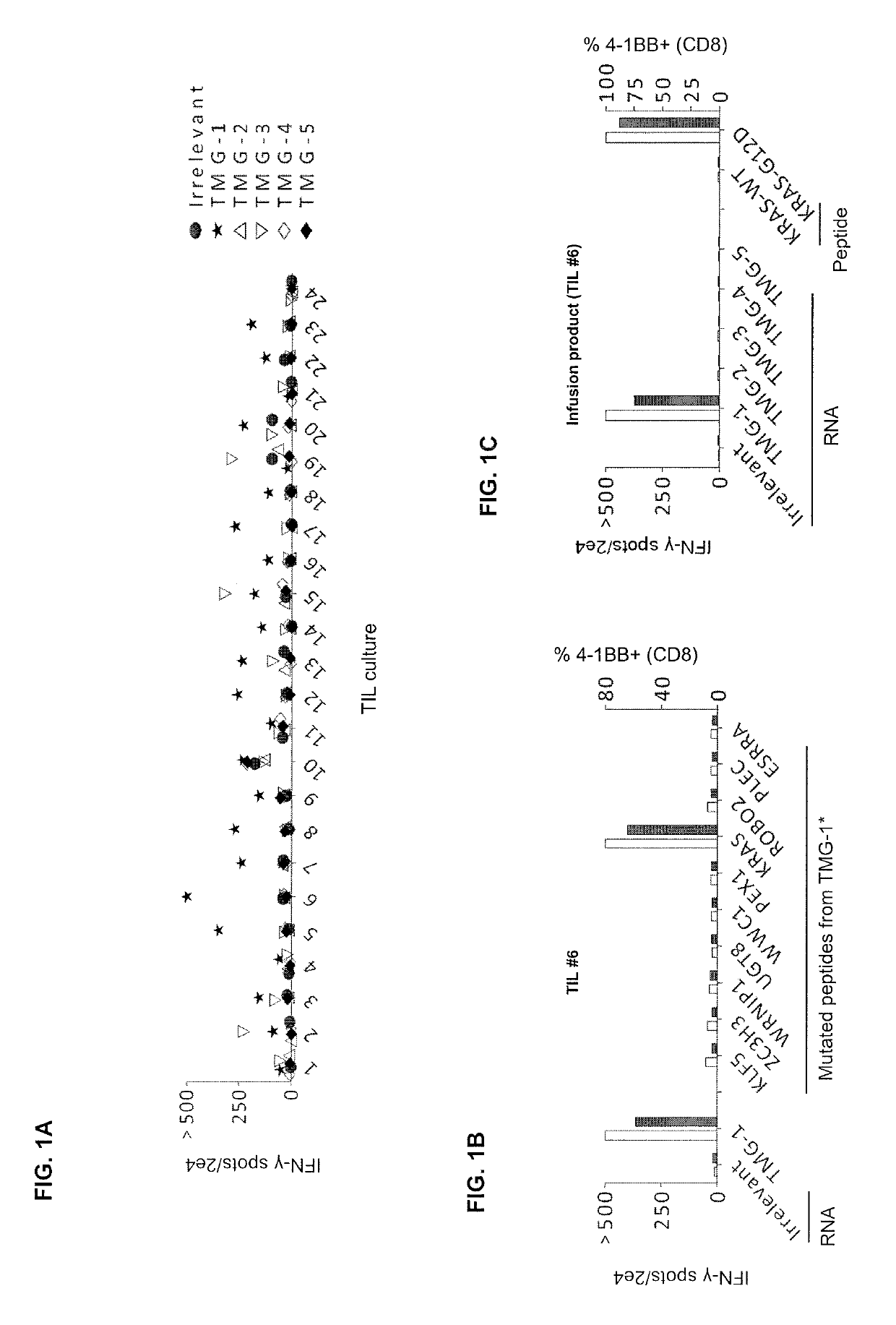Anti-kras-g12d t cell receptors
a t cell receptor and anti-kras-g12d technology, applied in the field of anti-kras-g12d t cell receptors, can solve the problems of poor prognosis of many cancers, limited treatment options for cancers, and poor prognosis for many cancers, for example, pancreatic, colorectal, ovarian, prostate cancer,
- Summary
- Abstract
- Description
- Claims
- Application Information
AI Technical Summary
Benefits of technology
Problems solved by technology
Method used
Image
Examples
example 1
[0125]This example demonstrates the in vivo frequency of KRASG12D mutation-reactive CD8+ T cells.
[0126]The patient was a 49-year old female with colorectal adenocarcinoma and multiple bilateral pulmonary metastases. She previously received 12 cycles of FOLFOX chemotherapy after a sigmoid colectomy and partial cystectomy, followed by 4182 cGy radiation to the bladder suture line. Shortly after this, she experienced an increase in the number and size of FDG avid bilateral pulmonary nodules. Biopsy of a right lower lobe nodule was consistent with metastatic colorectal adenocarcinoma.
[0127]The patient was enrolled on the institutional review board-approved phase II clinical trial (ClinicalTrials.gov number, NCT01174121) designed to test whether the adoptive transfer of ex vivo expanded tumor-infiltrating lymphocytes (TILs) containing T cells targeting cancer mutations can mediate regression of metastatic solid cancers. Baseline CT scans revealed lung disease as the sole source of cancer...
example 2
[0129]This example demonstrates the specificity and sensitivity of the KRASG12D-reactive TCRs.
[0130]The nucleotide sequence encoding the TCR was cloned from each of the four KRASG12D-reactive T-cell clonotypes of Example 1. Each TCR was cloned into an MSGV1-retroviral vector. The amino acid sequences of the alpha and beta chains of each of the four TCRs is shown in Table 6.
TABLE 6Variable Region AlphaVariable Region BetaTCR-α / TCR-β GeneChain Amino AcidChain Amino AcidNameSequenceSequenceTRAV4 / SEQ ID NO: 15SEQ ID NO: 16TRBV5-6 (A)TRAV12-2 / SEQ ID NO: 39SEQ ID NO: 40TRBV10-2TRAV4 / SEQ ID NO: 31SEQ ID NO: 32TRBV5-6 (B)TRAV4 / SEQ ID NO: 23SEQ ID NO: 24TRBV5-6 (C)
[0131]The nucleotide sequence cloned into the MSGV1-retroviral vector encoded the variable region of the TCR alpha chain (shown in Table 6) and the murine TCR alpha chain constant region, followed by a P2A linker sequence (SEQ ID NO: 58) and a nucleotide sequence encoding the variable region of the TCR beta chain (shown in Table 6)...
example 3
[0135]This example demonstrates that cells transduced to express the TRAV12-2 / TRBV10-2 TCR (SEQ ID NOs: 56 and 57) recognize mutated KRAS in the context of HLA allele C*08:02 or C*05:01.
[0136]Autologous peripheral blood T cells were genetically modified to express one of the four TCRs as described in Example 2. COST cells were co-transfected with full length wild-type (wt) KRAS or KRAS-G12D genes and the HLA allele C*07:01, C*08:02, or C*05:01, followed by co-culture with the indicated KRASG12D-reactive TCR transduced cells. Cells were analyzed for 4-1BB expression by flow cytometry the next day. The results are shown in FIGS. 5A-5D. Data were gated on TCR-transduced (mouse TCRβ+) CD8+ T cells. HLA-C*07:01 served as a negative control HLA allele.
[0137]All references, including publications, patent applications, and patents, cited herein are hereby incorporated by reference to the same extent as if each reference were individually and specifically indicated to be incorporated by refe...
PUM
 Login to View More
Login to View More Abstract
Description
Claims
Application Information
 Login to View More
Login to View More - R&D
- Intellectual Property
- Life Sciences
- Materials
- Tech Scout
- Unparalleled Data Quality
- Higher Quality Content
- 60% Fewer Hallucinations
Browse by: Latest US Patents, China's latest patents, Technical Efficacy Thesaurus, Application Domain, Technology Topic, Popular Technical Reports.
© 2025 PatSnap. All rights reserved.Legal|Privacy policy|Modern Slavery Act Transparency Statement|Sitemap|About US| Contact US: help@patsnap.com



